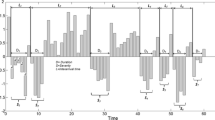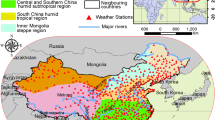Abstract
Drought severity and duration are usually modelled independently. However, these two characteristics are known to be related. To model this relationship, a joint distribution of drought severity and duration using a bivariate copula model is proposed and applied to daily rainfall data (1976–2007) of 30 rain gauge stations in Peninsular Malaysia. The drought characteristics are classified using the standardized precipitation index (SPI) and their univariate marginal distributions are further identified by fitting exponential, gamma, generalized extreme value, generalized gamma, generalized logistics, generalized pareto, gumbel max, gumbel min, log-logistic, log-pearson3, log-normal, normal, pearson 5, pearson 6 and weibull distributions. The three-parameter log-normal distribution is identified as the best fitting distribution for drought severity while the generalized pareto distribution is determined as the most appropriate distribution for drought duration with respect to the application of the Anderson-Darling procedure. The dependency among the drought properties is analysed using Kendall’s τ method. The maximum likelihood estimation of the univariate marginal distributions and the maximisation of the bivariate likelihood are employed to compute the Akaike Information Criterion (AIC) values in verifying the best fitting copula distribution. The Galambos distribution is recognised as the most appropriate copula distribution for describing the relationship between drought severity and duration. The conditional drought probability and drought return period are further described to explain the drought properties comprehensively. The probabilities of drought occurrences under certain circumstances with a specific seriousness or duration can be determined in order to verify the possibility of drought episodes. The return period of a recurrent drought has also been investigated to identify the time-interval for repeated drought occurrences under similar situation.









Similar content being viewed by others
References
Al-Salihi AH (2003) Drought identification and characterization in Jordan. J Arid Environ 53(4):585–606
Angelidis P, Maris F, Kotsovinos N, Hrissanthou V (2012) Computation of drought index SPI with alternative distribution functions. Water Resour Manag 26:2453–2473
Arshad M, Rasool MT, Ahmad MI (2003) Anderson darling and modified anderson darling tests for generalized pareto distribution. Pakistan J Appl Sci 3(2):85–88
Bacanli UG, Dikbas F, Baran T (2008) Drought analysis and a sample study of Aegean Region. Sixth International Conference on Ethics and Environmental Policies, Padova, 23–25 October
Bonaccorso B, Bordi I, Cancelliere A, Rossi G, Sutera A (2003) Spatial variability of drought: an analysis of the SPI in Sicily. Water Resour Manag 17:273–296
Cancelliere A, Mauro DG, Bonaccorso B, Rossi G (2007) Drought forecasting using the standardized precipitation index. Water Resour Manag 21:801–819
Chowdhary H, Escobar LA, Singh VP (2011) Identification of suitable copulas for bivariate frequency analysis of flood peak and flood volume data. Hydrol Res 4(2–3):193–216
Ganguli P, Reddy MJ (2012) Risk assessment of droughts in Gujarat using bivariate copulas. Water Resour Manag 26:3301–3327
Gibbs WJ, Maher JV (1967) Rainfall deciles as drought indicators, Bureau of Meteorology bulletin No. 48. Commonwealth of Australia, Melbourne, 29
Gudendorf G, Segers J (2010) Extreme-value copulas. Copula theory and its applications. Springer, Berlin, pp 127–145
Jabatan Pengairan and Saliran Malaysia (JPS) (2007) Flood and drought management in Malaysia. Ministry of Natural Resources & Environment
Joe H (1997) Multivariate models and dependence concepts. Chapman and Hall, New York
Khan S, Gabriel HF, Rana T (2008) Standard precipitation index to track drought and assess impact of rainfall on watertables in irrigation areas. Irrig Drainage Syst 22(2):159–177
McKee TB, Doesken NJ, Kleist J (1993) The relationship of drought frequency and duration on time scales. Preprints, Eighth Conf on Applied Climatology, Anaheim, CA. Am. Meteor. Soc., Boston, pp 179–184
Mirabbasi R, Fakheri-Fard A, Dinpashoh Y (2012) Bivariate drought frequency analysis using the copula method. Theor Appl Climatol 108:191–206
Morid S, Smakhtin V, Moghaddasi M (2006) Comparison of seven meteorological indices for drought monitoring in Iran. Int J Climatol 26:971–985
Nalbantis I, Tsakiris G (2009) Assessment of hydrological drought revisited. Water Resour Manag 23:881–897
Nelsen RB (2006) An introduction to copulas. Springer, New York
Paulo AA, Ferreira E, Coelho C, Pereira LS (2005) Drought class transition analysis through markov and loglinear models, an approach to early warning. Agr Water Manag 77:59–81
Qian W, Lin X (2005) Regional trends in recent precipitation indices in China. Meteorol Atmos Phys. doi:10.1007/s00703-004-0101-z
Santos JF, Portela MM, Pulido-Calvo I (2011) Regional frequency analysis of droughts in Portugal. Water Resour Manag 25:3537–3558
Serinaldi F (2008) Analysis of inter-gauge dependence by kendall’s τ k , upper tail dependence coefficient, and 2-copulas with application to rainfall fields. Stoch Environ Res Risk Assess 22:671–688
Shiau JT (2006) Fitting drought duration and severity with two-dimensional copulas. Water Resour Manag 20:795–815
Sirdas S, Sen Z (2001) Application of the standardized precipitation index (SPI) to the Marmara Region, Turkey. Integrated Water Resources Management. IAHS Publ. no. 272.2001, pp. 291–296
Sklar A (1959) Fonctions de repartition a n Dimensions et Leura Marges. Publ Inst Stat Univ Paris 8:229–231
Tsakiris G, Pangalou D, Vangelis H (2007) Regional drought assessment based on the Reconnaissance Drought Index (RDI). Water Resour Manag 25:1087–1101
Wong G, Lambert MF, Metcalfe AV (2008) Trivariate copulas for characterisation of droughts. ANZIAM J 49:C306–C323
Zhai JQ, Liu B, Hartmann H, Su BD, Jiang T, Fraedrich K (2009) Dryness / wetness variations in China during the first 50 years of the 21st century. Hydrol Earth Syst Sci Discuss 6:1385–1409
Zhang Q, Xu CY, Zhang Z (2009) Observed changes of drought / wetness episodes in the Pearl River Basin, China, using the standardized precipitation index and aridity index. Theor Appl Climatol 98:89–99
Zin WZW, Ibrahim K, Jemain AA (2010) Evaluating the dry conditions in Peninsular Malaysia using bivariate copula. ANZIAM J 51:C555–C569
Zin WZW, Jemain AA, Ibrahim K (2013) Analysis of drought condition and risk in Peninsular Malaysia using standardised precipitation index. Theor Appl Climatol 111:559–568
Acknowledgments
The authors are grateful to the Malaysian Meteorological Department and the Malaysian Drainage and Irrigation Department for providing the daily precipitation data. The work is financed by MyPhD Scholarship provided by the Ministry of Higher Education of Malaysia, FRGS vot 4F23 and Universiti Teknologi Malaysia.
Author information
Authors and Affiliations
Corresponding author
Rights and permissions
About this article
Cite this article
Yusof, F., Hui-Mean, F., Suhaila, J. et al. Characterisation of Drought Properties with Bivariate Copula Analysis. Water Resour Manage 27, 4183–4207 (2013). https://doi.org/10.1007/s11269-013-0402-4
Received:
Accepted:
Published:
Issue Date:
DOI: https://doi.org/10.1007/s11269-013-0402-4




